
In the River TAKAHARA --Vol.80--

In March when the River Kuzuryu was filled with snow melting water, the mountain stream was covered with snow everywhere.
Piling Sand
The more often I go fishing to the River Kuzuryu for cherry salmon, the less I go to the River Takahara. I had expected so but it was not true. I still went to the River Takahara not infrequently. It was not my plan but the river conditions guided me to my old river.I fished cherry salmon in the River Kuzuryu mainly in March and April, when snow melting water was flowing. But in those months it rained every third day. Even light rain melted the lying snow on the course of the river and all flowed together. At the next moment the river became high and muddy water. When a large amount of rain fell in the source area and the dam on the upper reaches drained water off, the river was filled with muddy water and anglers could do nothing for a day or more.
I did not mind waiting when I had extra time. When I could not wait vainly but hated to go home with my hands empty, I dropped in at another river on the way to Tokyo to enjoy fishing for a while.
Finding a suitable river on my way back was an easy job in May and June but not so in March and April, when spring had just come in mountains. As the banks were still covered with snow everywhere, fishing seemed to be too early. That was why I continued to go fishing to the River Takahara, which guaranteed us fishing from early March.
To travel from the River Kuzuryu to the River Takahara, I usually drove Hokuriku Road as far as Toyama and turned to the south along National Route 41. Then I went upstream along the River Jintu, another name of the River Takahara. Finally I arrived at Tochio.
The River Jintu flowed gently as far as Ohsawano town. Then it passed the third dam outside the town and flowed into the mountain area, forming a V-shaped valley with narrow banks. The river name was changed into the River Takahara and it flowed to Kamioka town.
The condition of the river flowing on the valley bottom was clearly seen from the road. There were many spots where I wanted to fish someday. Unfortunately the river was cut into sections by a lot of dams and possible fishing spots were surrounded by terribly steep slopes that refused us walking down. Anyway, it was too early to fish those valley spots in early spring.
When fishing season came in those spots in early summer, other rivers were also in good condition. So my dream always ended in dream.

Some fish were caught in such snowy scenery in the River Takahara, the treasure river for anglers.
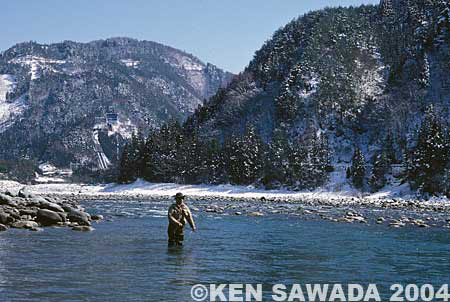
Snow often remained in the end of March at the upper reaches of Kamioka.
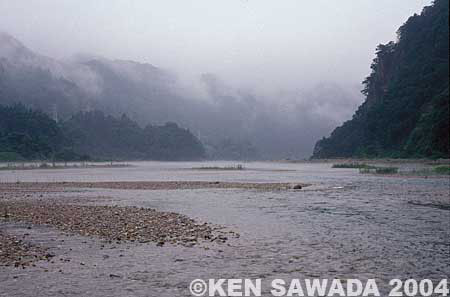
Snow finally melted in April near the Asaida dam in the River Takahara.
Drainage of Water from the Dam
In 1988 I could catch some cherry salmon, my longtime dream fish, in the River Kuzuryu (see Vol.42 and after). I felt satisfied. When cherry salmon season was over in June I planned to fish the lower reaches of the River Takahara, my longtime dream spots I had been watching from my car window.Unfortunately when I started to try those spots, one of the dams opened the water gate to push away earth and sand. Mr. Shohei Katoh, my fishing companion, and I were struck dumb, looking at the river where the water finished being drained from the dam a week before.
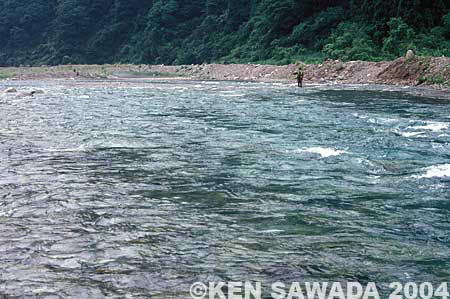
The river started to rise and soon snow-melting-water season really came.
Usually a blue deep pool spread with rich water on the valley bottom. But now white sand covered the gentle valley as far as we could look down from the bridge. It was such horrible scenery that we felt chilly. Where are fish now? Were they pushed away with so much sand?
It was too late to regret. We should have come here earlier. We could do nothing but got frustrated.
Do some fish move and survive at the dam downstream? If so, they will come upstream again. But when will the river bed be suitable enough for fish to come back? Next week, next month or some years later?
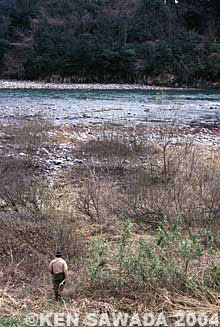
Cherry salmon season came in April near Ohsawano in the River Jintu.
That was all we talked of as we looked at the white river, standing on the bridge.
A Transparent Shadow
What should we do now? The sun is still high. Are there any suitable rivers to go fishing from now on? The source area must be too early for fishing but some tributaries and the middle reaches of the river looked nice. We listed nearby creeks and wondered which to go.Leaning on the parapet, we still talked. Then I felt the sand downstream moving. The rough surface swayed the white sand bottom like heat haze. At first I could not believe my eyes, judging from the condition of the stream. I kept watching the spot.
Something was swaying and it came upstream to us. I clearly saw that.
“Look, something is swimming.”
I pointed at the surface downstream. We stared and stared at the surface. Something white and transparent like a ghost was coming near to the bridge.
“A char!”
Where has it come from? Probably because it had been swimming over the white sand its body turned white. It was rather big, more than trophy-sized, probably over 35cm.
The white char swayed its body like a snake and passed under the bridge. Waiting for some cars to pass, we crossed the road and stared at the fish from the opposite side. The char came upstream at the same pace. It passed under our feet and headed farther upstream. Then it was out of sight at the blinding surface.
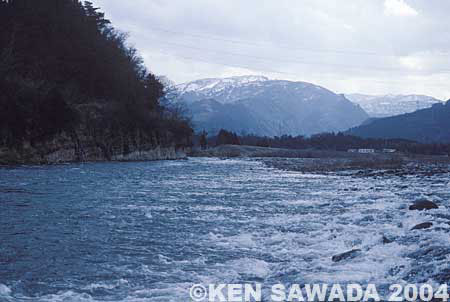
Near the third dam the gentle river was changed into a valley.
“Here is a fish!”
“It’s a miracle. It survives here.”
We stared at each other. We said nothing but knew what each of us was thinking about. We looked around to find a route walking down to the river, watching the cliff upstream.
Here near the bridge terribly steep slope spread like a sheer cliff. Fortunately there was a gentle slope covered with trees and bamboos 100m upstream. It seemed that we could manage to walk down there.
Preparing for fishing we walked through the field and headed for the bamboo grove. Bamboos are so deep-rooted in spite of their thin trunks that we can support ourselves safely. Looking through the bamboo grove, we thought that we would be able to walk down to the river.
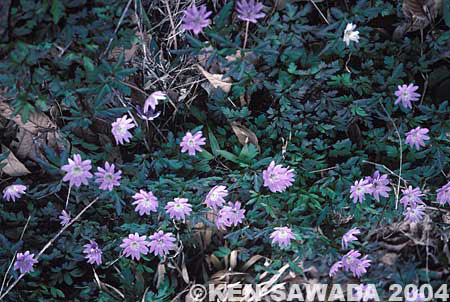
In May edible wild plants came into bud and flowers were in full bloom everywhere on the cliff.
On the way to walk down the cliff Mr. Shohei Katoh with quick eyes found native leeks. For some reason they grew well along the River Jintu. Picking up a bunch of them, we walked down and stood at the bank.
White sands were piled on the river bottom and a magnificent stone showed only its upper half on the surface like a bamboo shoot on the ground. It is true that we saw a char swimming but how many fish are there?
We could see the bridge downstream from where we had watched down the river. It was 100m away, a sufficient distance to check how the fish were staying. We did not need to go together. Mr. Shohei Katoh headed upstream and I headed downstream.
-- To be continued --
- NET SHOP INFORMATION
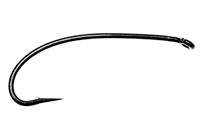
SL6 Black Spey Hooks
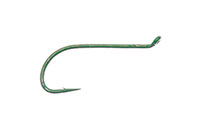
DU3 Limerick Spinner Hooks
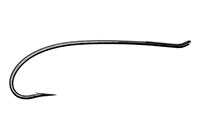
SL4 Single Bartleet Hooks
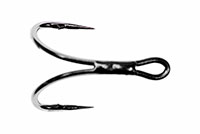
XD1 Tube Fly Double Hooks
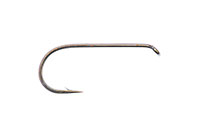
DD2 Flat Perfect Hooks
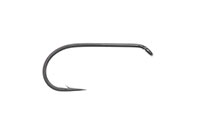
DD1 Black Terrestrial Hooks
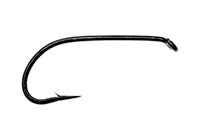
TD4 Old Limerick Wet Hooks
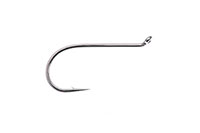
DU1 Silver May Hooks
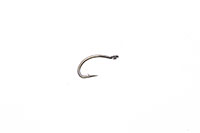
MU1 Flat Midge Hooks
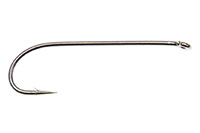
LD3 Long Limerick Hooks
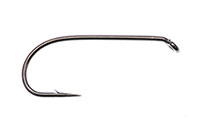
TD2 Summer Sproat Hooks
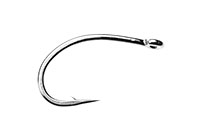
XS1 Tube Single Silver Hooks
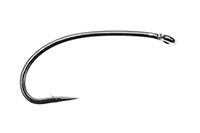
TD6 Siver Sedge Hooks

SL5 Black Spey Hooks

DU3 Limerick Spinner Hooks
- TROPHY CLUB
- FLY SHOW
- EXHIBITION
- MASTERS`
- FLY DRESSING CONTEST Archives
- TRAVELLER Archives
- TACKLE IMPRESSIONS Archives
- ANGLERS` PHOTO GALLERY Archives
- ----------------------------------------------
- トロフィークラブ
- フライショー
- エキシビション
- マスターズ
- フライドレッシング・コンテスト・アーカイヴ
- トラヴェラー・アーカイヴ
- タックル・インプレッション・アーカイヴ
- アングラーズ・フォトギャラリー・アーカイヴ
株式会社サワダ 185-0021 東京都国分寺市南町3-13-4
SAWADA'S INC. 3-13-4 Minamicho, Kokubunji, Tokyo 185-0021, Japan
写真・ドキュメントの無断転載を禁じます。
All the images and documents found on this site are owned by Ken Sawada and may not be used without permission.
But, link to this site is FREE.
Copyright © 2000 - 2025 SAWADA'S INC.. All rights reserved.
SAWADA'S INC. 3-13-4 Minamicho, Kokubunji, Tokyo 185-0021, Japan
写真・ドキュメントの無断転載を禁じます。
All the images and documents found on this site are owned by Ken Sawada and may not be used without permission.
But, link to this site is FREE.
Copyright © 2000 - 2025 SAWADA'S INC.. All rights reserved.
